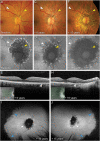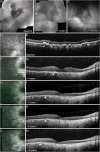MULTIZONAL OUTER RETINOPATHY AND RETINAL PIGMENT EPITHELIOPATHY (MORR): A Newly Recognized Entity or an Unusual Variant of AZOOR?
- PMID: 37748093
- PMCID: PMC10589432
- DOI: 10.1097/IAE.0000000000003927
MULTIZONAL OUTER RETINOPATHY AND RETINAL PIGMENT EPITHELIOPATHY (MORR): A Newly Recognized Entity or an Unusual Variant of AZOOR?
Abstract
Purpose: To describe specific clinical, multimodal imaging, and natural history features of an unusual variant of acute zonal occult outer retinopathy.
Methods: Retrospective, observational, longitudinal, multicenter case series. Patients exhibiting this unusual clinical condition among cases previously diagnosed with acute zonal occult outer retinopathy were included. Multimodal imaging, laboratory evaluations, and genetic testing for inherited retinal diseases were reviewed.
Results: Twenty eyes from 10 patients (8 females and 2 males) with a mean age of 54.1 ± 13.3 years (range, 38-71 years) were included. The mean follow-up duration was 13.1 ± 5.3 years (range, 8-23 years). Presenting symptoms were bilateral in 7 patients (85% of eyes) and included scotomata and photopsia. All patients had bilateral lesions at presentation involving the peripapillary and far peripheral retina. Baseline optical coherence tomography showed alteration of the retinal pigment epithelium and photoreceptor layers corresponding to zonal areas of fundus autofluorescence abnormalities. Centrifugal and centripetal progression of the peripapillary and far-peripheral lesions, respectively, occurred over the follow-up, resulting in areas of complete outer retinal and retinal pigment epithelium atrophy.
Conclusion: Initial alteration of photoreceptors and retinal pigment epithelium and a stereotypical natural course that includes involvement of the far retinal periphery, characterize this unusual condition. It may represent a variant of acute zonal occult outer retinopathy or may be a new entity. We suggest to call it multizonal outer retinopathy and retinal pigment epitheliopathy .
Copyright © 2023 The Author(s). Published by Wolters Kluwer Health, Inc. on behalf of the Opthalmic Communications Society, Inc.
Conflict of interest statement
K. B. Freund is a consultant for Heidelberg Engineering, Zeiss, Allergan, Bayer, Genentech, and Novartis and receives research support from Genentech/Roche. None of the remaining authors has any financial/conflicting interests to disclose.
Figures







Similar articles
-
A case documenting distinct natural history of multizonal outer retinopathy and retinal pigment epitheliopathy (MORR) with longitudinal multi-modal documentation of progression.Am J Ophthalmol Case Rep. 2024 Nov 29;36:102222. doi: 10.1016/j.ajoc.2024.102222. eCollection 2024 Dec. Am J Ophthalmol Case Rep. 2024. PMID: 39697673 Free PMC article.
-
Acute zonal occult outer retinopathy: a classification based on multimodal imaging.JAMA Ophthalmol. 2014 Sep;132(9):1089-98. doi: 10.1001/jamaophthalmol.2014.1683. JAMA Ophthalmol. 2014. PMID: 24945598
-
Fundus autofluorescence and optical coherence tomographic findings in acute zonal occult outer retinopathy.Retina. 2010 Sep;30(8):1206-16. doi: 10.1097/IAE.0b013e3181e097f0. Retina. 2010. PMID: 20661173
-
Current understanding of acute zonal occult outer retinopathy (AZOOR).Indian J Ophthalmol. 2024 Jul 1;72(7):935-937. doi: 10.4103/IJO.IJO_3228_23. Epub 2024 Mar 8. Indian J Ophthalmol. 2024. PMID: 38454854 Free PMC article. Review.
-
Acute Zonal Occult Outer Retinopathy (AZOOR) and Related Diseases.Adv Exp Med Biol. 2018;1085:233-237. doi: 10.1007/978-3-319-95046-4_49. Adv Exp Med Biol. 2018. PMID: 30578522 Review.
Cited by
-
Multizonal outer retinopathy and retinal pigment epitheliopathy (MORR) with a chronologically divergent presentation- a case report.J Ophthalmic Inflamm Infect. 2025 Jul 22;15(1):57. doi: 10.1186/s12348-025-00519-0. J Ophthalmic Inflamm Infect. 2025. PMID: 40694285 Free PMC article.
-
A Case of an Acute Zonal Occult Outer Retinopathy Variant Characterized With an Insidious Peripheral Onset and Centripetal Progression.Cureus. 2024 May 3;16(5):e59600. doi: 10.7759/cureus.59600. eCollection 2024 May. Cureus. 2024. PMID: 38826932 Free PMC article.
-
A case documenting distinct natural history of multizonal outer retinopathy and retinal pigment epitheliopathy (MORR) with longitudinal multi-modal documentation of progression.Am J Ophthalmol Case Rep. 2024 Nov 29;36:102222. doi: 10.1016/j.ajoc.2024.102222. eCollection 2024 Dec. Am J Ophthalmol Case Rep. 2024. PMID: 39697673 Free PMC article.
-
The importance of genetic and electrophysiological studies in the differential diagnosis of acute zonal occult outer retinopathy (AZOOR).Indian J Ophthalmol. 2025 Jan 1;73(Suppl 1):S181-S183. doi: 10.4103/IJO.IJO_1989_24. Epub 2024 Dec 24. Indian J Ophthalmol. 2025. PMID: 39723879 Free PMC article. No abstract available.
References
-
- Gass JD. Acute zonal occult outer retinopathy. Donders lecture: The Netherlands ophthalmological society, Maastricht, Holland, June 19, 1992. J Clin Neuroophthalmol 1993;13:79–97. - PubMed
-
- Gass JD, Agarwal A, Scott IU. Acute zonal occult outer retinopathy: a long-term follow-up study. Am J Ophthalmol 2002;134:329–339. - PubMed
-
- Mrejen S, Khan S, Gallego-Pinazo R, et al. . Acute zonal occult outer retinopathy: a classification based on multimodal imaging. JAMA Ophthalmol 2014;132:1089–1098. - PubMed
-
- Spaide RF. Collateral damage in acute zonal occult outer retinopathy. Am J Ophthalmol 2004;138:887–889. - PubMed
-
- Vadboncoeur J, Jampol LM, Goldstein DA. Acute zonal occult outer retinopathy: a case report of regression after an intravitreal dexamethasone (OZURDEX) implant. Retin Cases Brief Rep 2022;16:466–469. - PubMed
Publication types
MeSH terms
Substances
Supplementary concepts
LinkOut - more resources
Full Text Sources
Medical
Miscellaneous

